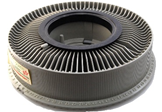 We have done the hard part for you: duplicating your photonic legacy library into today’s digital domain. But the ultimate experience is in your ability to view your family memories. Below are some ideas on what might be beneficial for you.
We have done the hard part for you: duplicating your photonic legacy library into today’s digital domain. But the ultimate experience is in your ability to view your family memories. Below are some ideas on what might be beneficial for you.
FIRST STEPS:
Your family memories have come to you on either a professional grade CD-ROM or DVD-ROM. These are unlike consumer grade media in that they have extremely long longevities. While consumer grade media is good for up to 10 years you can expect pro-grade media to last well beyond our lifetimes. However, because you can’t guarantee loss of the disk from fire, flooding, or other disasters you should copy the disk and distribute to other family members.1
It is critical in the duplication of family heirloom legacy media to digital to maintain a link between the original physical media and its digital representation. At W. Cardone Productions we have taken every effort to maintain this link for you but in order to utilize its benefits you must understand the simple philosophy behind what we have done.
 In most cases family films and slides have some sort of organization when they reach our film bench. With 35mm slides the most common organization we see is a set of carousels. A typical slide carousel is illustrated on the right. Each carousel holds up to either 100 or 140 slides. Each bin holding each slide has an index number. The corresponding digital duplication for any given slide will have a matching index number appended to its file name.
In most cases family films and slides have some sort of organization when they reach our film bench. With 35mm slides the most common organization we see is a set of carousels. A typical slide carousel is illustrated on the right. Each carousel holds up to either 100 or 140 slides. Each bin holding each slide has an index number. The corresponding digital duplication for any given slide will have a matching index number appended to its file name.
So, here is how this works. The computer disk file structure will be made to reflect in some way the organization of the library. Say for example a library consists of ten carousels. Typically each carousel will have some sort of identification such as, “Vacation of 1962.” Your project disk will then have a folder of that same name. Let us also suppose that this carousel was holding 72 slides. The “Vacation 1962” folder will have 72 image files and each file will have an index number appended to its name. There will be a base name all the files will have with a unique numerical suffix to each.
Why is this important to maintain a link between the original media and your digital duplications of them? The reason is that there are typically important clues on the original media suggesting the nature of the image such as, “Bobby’s first birthday.” It would be a major loss to discard this link.
ATTACH COMMENTS TO YOUR DIGITAL PHOTOS:
The one thing that we could not do for you was annotate your digital pictures with notes often left on the pictures or with information otherwise available from the family. We recommend you annotate your digital images using the procedure described in the accompanying document titled “Attaching Comments to Photos.” It is a labor-intense task but worth your while.
OBTAIN COLOR PRINTS:
Color prints can be handled, passed around, framed for wall display, and many other viewing applications. But all we have given you are computer files. Most department and drug stores have dedicated floor space for you to make color prints from your digital images and at a very reasonable cost since you are performing the labor. This task is very monkey-see-monkey-do. There are no required imaging decisions to make, no technology to understand, no nothing really. There will be options to enhance images such as eliminating red-eye from photos but these are options that are not critical. About all you have to decide is what size print you want and how many.
UPLOAD TO YOUR MOBILE DEVICE:
Once your library had been downloaded from our original CD-ROM disk to your computer you can from there upload individual photos to your mobile device to always have with you.
